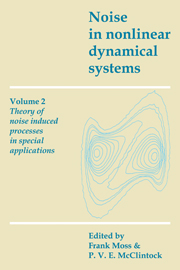Book contents
- Frontmatter
- Contents
- List of contributors
- Preface
- Introduction to Volume 2
- 1 Stochastic processes in quantum mechanical settings
- 2 Self-diffusion in non-Markovian condensed-matter systems
- 3 Escape from the underdamped potential well
- 4 Effect of noise on discrete dynamical systems with multiple attractors
- 5 Discrete dynamics perturbed by weak noise
- 6 Bifurcation behavior under modulated control parameters
- 7 Period doubling bifurcations: what good are they?
- 8 Noise-induced transitions
- 9 Mechanisms for noise-induced transitions in chemical systems
- 10 State selection dynamics in symmetry-breaking transitions
- 11 Noise in a ring-laser gyroscope
- 12 Control of noise by noise and applications to optical systems
- 13 Transition probabilities and spectral density of fluctuations of noise driven bistable systems
- Index
13 - Transition probabilities and spectral density of fluctuations of noise driven bistable systems
Published online by Cambridge University Press: 05 January 2012
- Frontmatter
- Contents
- List of contributors
- Preface
- Introduction to Volume 2
- 1 Stochastic processes in quantum mechanical settings
- 2 Self-diffusion in non-Markovian condensed-matter systems
- 3 Escape from the underdamped potential well
- 4 Effect of noise on discrete dynamical systems with multiple attractors
- 5 Discrete dynamics perturbed by weak noise
- 6 Bifurcation behavior under modulated control parameters
- 7 Period doubling bifurcations: what good are they?
- 8 Noise-induced transitions
- 9 Mechanisms for noise-induced transitions in chemical systems
- 10 State selection dynamics in symmetry-breaking transitions
- 11 Noise in a ring-laser gyroscope
- 12 Control of noise by noise and applications to optical systems
- 13 Transition probabilities and spectral density of fluctuations of noise driven bistable systems
- Index
Summary
Introduction
One of the important problems of physical kinetics is the investigation of relaxation and fluctuation phenomena in systems which have two or more stable states. Bi- and multistable systems are studied in various fields of physics, and the causes of multistability and the types of stable states are different in different cases. For systems moving in static potential fields (disregarding the interactions that give rise to relaxation and fluctuations in a system) multistability takes place if a potential has several minima. In this case the stable states are the equilibrium states. A number of systems of this type are investigated in solid state physics; in particular, diffusing atoms and impurity centers that reorient within a unit cell (see Narayanamurti and Pôhl, 1970).
Multistability may also arise in systems driven by an external periodic field. The constrained vibrations correspond to the stable states in this case (the attractors with a more complicated structure may also appear here). In particular, nonlinear oscillators of various physical nature refer to such systems (see Landau and Lifshitz, 1976). It is well known that in a certain frequency range the dependence of the amplitude A of the constrained vibrations of a nonlinear oscillator on the resonant external field amplitude h may be S-shaped (cf. curve (c) in Figure 13.1). In the range of the non-singlevalued dependence A(h) the states with the largest and smallest A are stable.
- Type
- Chapter
- Information
- Noise in Nonlinear Dynamical Systems , pp. 347 - 380Publisher: Cambridge University PressPrint publication year: 1989
- 8
- Cited by



